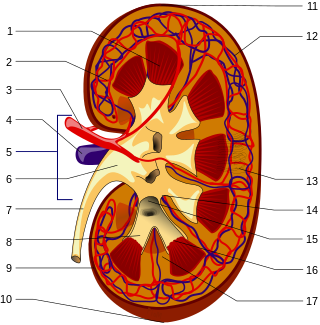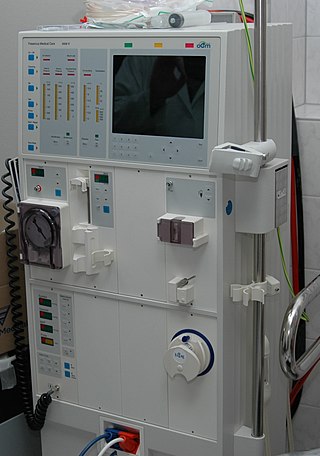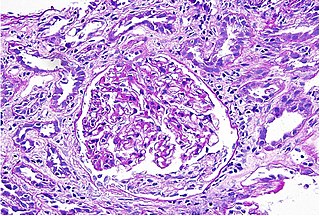Related Research Articles

Nephrology is a specialty for both adult internal medicine and pediatric medicine that concerns the study of the kidneys, specifically normal kidney function and kidney disease, the preservation of kidney health, and the treatment of kidney disease, from diet and medication to renal replacement therapy. The word "renal" is an adjective meaning "relating to the kidneys", and its roots are French or late Latin. Whereas according to some opinions, "renal" and "nephro" should be replaced with "kidney" in scientific writings such as "kidney medicine" or "kidney replacement therapy", other experts have advocated preserving the use of renal and nephro as appropriate including in "nephrology" and "renal replacement therapy", respectively.

Kidney failure, also known as end-stage renal disease (ESRD), is a medical condition in which the kidneys can no longer adequately filter waste products from the blood, functioning at less than 15% of normal levels. Kidney failure is classified as either acute kidney failure, which develops rapidly and may resolve; and chronic kidney failure, which develops slowly and can often be irreversible. Symptoms may include leg swelling, feeling tired, vomiting, loss of appetite, and confusion. Complications of acute and chronic failure include uremia, hyperkalemia, and volume overload. Complications of chronic failure also include heart disease, high blood pressure, and anaemia.

Amyloidosis is a group of diseases in which abnormal proteins, known as amyloid fibrils, build up in tissue. There are several non-specific and vague signs and symptoms associated with amyloidosis. These include fatigue, peripheral edema, weight loss, shortness of breath, palpitations, and feeling faint with standing. In AL amyloidosis, specific indicators can include enlargement of the tongue and periorbital purpura. In wild-type ATTR amyloidosis, non-cardiac symptoms include: bilateral carpal tunnel syndrome, lumbar spinal stenosis, biceps tendon rupture, small fiber neuropathy, and autonomic dysfunction.

Kidney disease, or renal disease, technically referred to as nephropathy, is damage to or disease of a kidney. Nephritis is an inflammatory kidney disease and has several types according to the location of the inflammation. Inflammation can be diagnosed by blood tests. Nephrosis is non-inflammatory kidney disease. Nephritis and nephrosis can give rise to nephritic syndrome and nephrotic syndrome respectively. Kidney disease usually causes a loss of kidney function to some degree and can result in kidney failure, the complete loss of kidney function. Kidney failure is known as the end-stage of kidney disease, where dialysis or a kidney transplant is the only treatment option.

Chronic kidney disease (CKD) is a type of kidney disease in which a gradual loss of kidney function occurs over a period of months to years. Initially generally no symptoms are seen, but later symptoms may include leg swelling, feeling tired, vomiting, loss of appetite, and confusion. Complications can relate to hormonal dysfunction of the kidneys and include high blood pressure, bone disease, and anemia. Additionally CKD patients have markedly increased cardiovascular complications with increased risks of death and hospitalization.

Membranous glomerulonephritis (MGN) is a slowly progressive disease of the kidney affecting mostly people between ages of 30 and 50 years, usually white people.

Nephritic syndrome is a syndrome comprising signs of nephritis, which is kidney disease involving inflammation. It often occurs in the glomerulus, where it is called glomerulonephritis. Glomerulonephritis is characterized by inflammation and thinning of the glomerular basement membrane and the occurrence of small pores in the podocytes of the glomerulus. These pores become large enough to permit both proteins and red blood cells to pass into the urine. By contrast, nephrotic syndrome is characterized by proteinuria and a constellation of other symptoms that specifically do not include hematuria. Nephritic syndrome, like nephrotic syndrome, may involve low level of albumin in the blood due to the protein albumin moving from the blood to the urine.

Interstitial nephritis, also known as tubulointerstitial nephritis, is inflammation of the area of the kidney known as the renal interstitium, which consists of a collection of cells, extracellular matrix, and fluid surrounding the renal tubules. It is also known as intestinal nephritis because the clinical picture may include mesenteric lymphadenitis in some cases of acute pyelonephritis. More specifically, in case of recurrent urinary tract infection, secondary infection can spread to adjacent intestine. In addition to providing a scaffolding support for the tubular architecture, the interstitium has been shown to participate in the fluid and electrolyte exchange as well as endocrine functions of the kidney.
Congenital nephrotic syndrome is a rare kidney disease which manifests in infants during the first 3 months of life, and is characterized by high levels of protein in the urine (proteinuria), low levels of protein in the blood, and swelling. This disease is primarily caused by genetic mutations which result in damage to components of the glomerular filtration barrier and allow for leakage of plasma proteins into the urinary space.

Leukocyte cell-derived chemotaxin-2 (LECT2) is a protein first described in 1996 as a chemotactic factor for neutrophils, i.e. it stimulated human neutrophils to move directionally in an in vitro assay system. The protein was detected in and purified from cultures of Phytohaemagglutinin-activated human T-cell leukemia SKW-3 cells. Subsequent studies have defined LECT2 as a hepatokine, i.e. a substance made and released into the circulation by liver hepatocyte cells that regulates the function of other cells: it is a hepatocyte-derived, hormone-like, signaling protein.
Amyloid light-chain (AL) amyloidosis, also known as primary amyloidosis, is the most common form of systemic amyloidosis. The disease is caused when a person's antibody-producing cells do not function properly and produce abnormal protein fibers made of components of antibodies called light chains. These light chains come together to form amyloid deposits which can cause serious damage to different organs. An abnormal light chain in urine is known as Bence Jones protein.
Haemodialysis-associated amyloidosis is a form of systemic amyloidosis associated with chronic kidney failure. Amyloidosis is the accumulation of misfolded protein fibers in the body that can be associated with many chronic illnesses. Even though amyloidosis is common in chronic kidney disease (CKD) patients receiving chronic regular dialysis, it has also been reported in a patient with chronic kidney failure but who never received dialysis.

Mesangial proliferative glomerulonephritis (MesPGN) is a morphological pattern characterized by a numerical increase in mesangial cells and expansion of the extracellular matrix within the mesangium of the glomerulus. The increase in the number of mesangial cells can be diffuse or local and immunoglobulin and/or complement deposition can also occur. MesPGN is associated with a variety of disease processes affecting the glomerulus, though can be idiopathic. The clinical presentation of MesPGN usually consists of hematuria or nephrotic syndrome. Treatment is often consistent with the histologic pattern of and/or disease process contributing to mesangial proliferative glomerulonephritis, and usually involves some form of immunosuppressant.
Glomerulonephrosis is a non-inflammatory disease of the kidney (nephrosis) presenting primarily in the glomerulus as nephrotic syndrome. The nephron is the functional unit of the kidney and it contains the glomerulus, which acts as a filter for blood to retain proteins and blood lipids. Damage to these filtration units results in important blood contents being released as waste in urine. This disease can be characterized by symptoms such as fatigue, swelling, and foamy urine, and can lead to chronic kidney disease and ultimately end-stage renal disease, as well as cardiovascular diseases. Glomerulonephrosis can present as either primary glomerulonephrosis or secondary glomerulonephrosis.

Light chain deposition disease (LCDD) is a rare blood cell disease which is characterized by deposition of fragments of infection-fighting immunoglobulins, called light chains (LCs), in the body. LCs are normally cleared by the kidneys, but in LCDD, these light chain deposits damage organs and cause disease. The kidneys are almost always affected and this often leads to kidney failure. About half of people with light chain deposition disease also have a plasma cell dyscrasia, a spectrum of diseases that includes multiple myeloma, Waldenström's macroglobulinemia, and the monoclonal gammopathy of undetermined significance premalignant stages of these two diseases. Unlike in AL amyloidosis, in which light chains are laid down in characteristic amyloid deposits, in LCDD, light chains are deposited in non-amyloid granules.
Atypical hemolytic uremic syndrome (aHUS), also known as complement-mediated hemolytic uremic syndrome, is an extremely rare, life-threatening, progressive disease that frequently has a genetic component. In most cases it can be effectively controlled by interruption of the complement cascade. Particular monoclonal antibodies, discussed later in the article, have proven efficacy in many cases.
Onconephrology is a specialty in nephrology that deals with the study of kidney diseases in cancer patients. A nephrologist who takes care of patients with cancer and kidney disease is called an onconephrologist. This branch of nephrology encompasses nephrotoxicity associated with existing and novel chemotherapeutics, kidney disease as it pertains to stem cell transplant, paraneoplastic kidney disorders, paraproteinemias, electrolyte disorders associated with cancer, and more as discussed below.

LECT2 Amyloidosis (ALECT2) is a form of amyloidosis caused by the LECT2 protein. It was found to be the third most common cause of amyloidosis in a set of more than 4,000 individuals studied at the Mayo Clinic; the first and second most common forms the disorder were AL amyloidosis and AA amyloidosis, respectively. Amyloidosis is a disorder in which the abnormal deposition of a protein in organs and/or tissues gradually leads to organ failure and/or tissue injury.
Monoclonal immunoglobulin deposition disease, or MIDD, is a disease characterised by the deposition of monoclonal immunoglobulins on the basement membrane of the kidney. Monoclonal immunoglobulins are produced by monoclonal plasma cells, which are found in a variety of plasma cell dyscrasias. The deposition of monoclonal immunoglobulins on the basement membrane of the kidney causes renal impairment. As well as the kidney, MIDD may also affect the liver, heart, peripheral nerves, lung and skin.

Richard Henry Reeve White was a paediatric nephrologist, emeritus Professor of Paediatric Nephrology from the University of Birmingham morphologist and archivist for British Association for Paediatric Nephrology.
References
- 1 2 Lachmann HJ, Goodman HJ, Gilbertson JA, Gallimore JR, Sabin CA, Gillmore JD, et al. (June 2007). "Natural history and outcome in systemic AA amyloidosis" (PDF). The New England Journal of Medicine. 356 (23): 2361–2371. doi:10.1056/NEJMoa070265. PMID 17554117. S2CID 18801734. Archived from the original (PDF) on 2014-01-09.
- ↑ Mitchell RS, Kumar V, Abbas AK, Fausto N (2007). "Chapter 5". Robbins Basic Pathology (8th ed.). Philadelphia: Saunders. ISBN 978-1-4160-2973-1.
- ↑ Roberts JR, Mank VM, Wolf RE, Buxbaum JN, Mubashir D, Dhawan R, et al. (19 December 2022). Talavera F, Goldberg E (eds.). "AA (Inflammatory) Amyloidosis Clinical Presentation". MedScape.
- 1 2 3 4 5 6 7 8 9 10 11 12 13 14 15 16 17 18 19 20 21 22 23 24 25 26 27 28 29 30 31 32 33 34 35 36 37 38 39 40 41 42 43 44 Obici L, Merlini G (2012). "AA amyloidosis: basic knowledge, unmet needs and future treatments". Swiss medical weekly. 142: w13580. doi:10.4414/smw.2012.13580. PMID 22653707.
- ↑ Ben Abdelghani K, Mahfoudhi M, Hriz A, El Kossai I, Khefifi A, Turki S, et al. (May 2010). "[AA amyloidosis complicating sarcoidosis: two cases and literature review]". La Revue de medecine interne. 31 (5): 369–71. doi:10.1016/j.revmed.2009.11.009. PMID 20381218.
- 1 2 3 4 5 6 7 8 9 10 11 Bharati J, Lahoud OB, Jhaveri KD, Izzedine H (31 May 2023). "AA amyloidosis associated with cancers". Nephrology, dialysis, transplantation : official publication of the European Dialysis and Transplant Association - European Renal Association. 38 (6): 1366–1374. doi:10.1093/ndt/gfac217. PMID 35867878.
- ↑ Gueutin V, Langlois AL, Shehwaro N, Elharraqui R, Rouvier P, Izzedine H (2013). "Nephrotic Syndrome Associated with Lung Cancer: A Rare Case of Malignancy Associated with AA Amyloidosis". Case Reports in Nephrology. 2013: 831903. doi: 10.1155/2013/831903 . PMC 3914250 . PMID 24558629.
- ↑ Kanat O, Evrensel T, Filiz G, Usta M, Baskan E, Dilek K, et al. (November 2003). "Systemic AA amyloidosis and nephrotic syndrome associated with small cell carcinoma of the bladder". Nephrology, dialysis, transplantation : official publication of the European Dialysis and Transplant Association - European Renal Association. 18 (11): 2453–4. doi:10.1093/ndt/gfg391. PMID 14551390.
- ↑ d'Ythurbide G, Kerrou K, Brocheriou I, Hertig A (September 2012). "Reactive amyloidosis complicated by end-stage renal disease 28 years after liquid silicone injection in the buttocks". BMJ Case Reports. 2012: bcr2012006803. doi:10.1136/bcr-2012-006803. PMC 4543521 . PMID 23035166.
- ↑ Emekli U, Tümerdem B, Demiryont M (2002). "Rupture of a silicone gel mammary prosthesis and amyloidosis: a case report". Aesthetic Plastic Surgery. 26 (5): 383–387. doi:10.1007/s00266-002-2022-x. PMID 12432480. S2CID 6865930.
- ↑ Goldman AB, Bansal M (March 1996). "Amyloidosis and silicone synovitis: updated classification, updated pathophysiology, and synovial articular abnormalities". Radiologic Clinics of North America. 34 (2): 375–94, xi. doi:10.1016/S0033-8389(22)00474-2. PMID 8633122. S2CID 251523786.
- ↑ Jung O, Haack HS, Buettner M, Betz C, Stephan C, Gruetzmacher P, et al. (November 2012). "Renal AA-amyloidosis in intravenous drug users--a role for HIV-infection?". BMC Nephrology. 13: 151. doi: 10.1186/1471-2369-13-151 . PMC 3519698 . PMID 23171281.
- ↑ "AA Amyloidosis". Amyloidosis Foundation. Retrieved 9 January 2022.
- ↑ "Amyloidosis: AA". Cleveland Clinic. Retrieved 9 January 2022.
- ↑ Biasucci LM, Liuzzo G, Grillo RL, Caligiuri G, Rebuzzi AG, Buffon A, et al. (February 1999). "Elevated levels of C-reactive protein at discharge in patients with unstable angina predict recurrent instability". Circulation. 99 (7): 855–860. doi: 10.1161/01.cir.99.7.855 . PMID 10027805.
- ↑ Lachmannn HJ (2015-03-19). "Long-Term Complications of Familial Mediterranean Fever". Familial Mediterranean Fever. Springer. ISBN 978-3319146157.
- ↑ Real de Asúa D, Costa R, Galván JM, Filigheddu MT, Trujillo D, Cadiñanos J (2014). "Systemic AA amyloidosis: epidemiology, diagnosis, and management". Clinical Epidemiology. 6: 369–377. doi: 10.2147/CLEP.S39981 . PMC 4218891 . PMID 25378951.
- 1 2 Roberts JR, Mank VM, Wolf RE, Buxbaum JN, Mubashir D, Dhawan R, et al. (2019-02-02). Talavera F, Goldberg E (eds.). "AA (Inflammatory) Amyloidosis". Medscape Reference.
- ↑ "AA Amyloidosis". Amyloidosis Center. Boston University School of Medicin e.
- ↑ Katagiri D, Noiri E, Hinoshita F (2013). "Multiple myeloma and kidney disease". TheScientificWorldJournal. 2013: 487285. doi: 10.1155/2013/487285 . PMC 3826468 . PMID 24288486.
- ↑ Real de Asúa D, Costa R, Galván JM, Filigheddu MT, Trujillo D, Cadiñanos J (2014). "Systemic AA amyloidosis: epidemiology, diagnosis, and management". Clinical Epidemiology. 6: 369–377. doi: 10.2147/CLEP.S39981 . PMC 4218891 . PMID 25378951.
- ↑ Fernández-Nebro A, Tomero E, Ortiz-Santamaría V, Castro MC, Olivé A, de Haro M, et al. (May 2005). "Treatment of rheumatic inflammatory disease in 25 patients with secondary amyloidosis using tumor necrosis factor alpha antagonists". The American Journal of Medicine. 118 (5): 552–556. doi:10.1016/j.amjmed.2005.01.028. PMID 15866260.
- 1 2 Murakami T, Ishiguro N, Higuchi K (March 2014). "Transmission of systemic AA amyloidosis in animals". Veterinary Pathology. 51 (2): 363–371. doi: 10.1177/0300985813511128 . PMID 24280941.